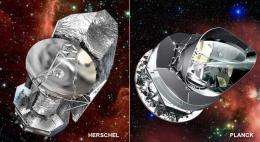Europe is about to take an astronomical lead over U.S.

The world's astronomers are about to get a trio of powerful new eyes on the sky that can see better and farther than existing space telescopes.
As a result, Europe will hold a scientific and technological lead over the United States in some key areas of cosmology, at least for a while.
On Monday, NASA will send a crew of astronauts to install greatly improved instruments on the 18-year-old Hubble Space Telescope. Just three days later, the European Space Agency will launch two even more advanced telescopes, named Planck and Herschel.
The American and European launchings will be "right on top of each other," said Jon Morse, the director of NASA's Astrophysics Division.
If all three instruments work as planned, scientists will be able to look back almost to the birth of the universe 13.7 billion years ago. They could detect the first stars and galaxies, and prove -- or disprove -- theories about what happened in the first seconds after the "big bang," when cosmologists think that everything began.
Each of the three telescopes "sees" things in a different wavelength of the electromagnetic spectrum. It's like looking through different windows on the cosmos.
Hubble sees mostly in optical light, the narrow band between infrared and ultraviolet that's visible to human eyes. Herschel will collect photons -- particles of light -- in a much wider infrared wavelength. Planck detects even longer microwaves, which carry photons left over from the big bang.
The three telescopes will study "different pieces of the universe," said Ray Villard, Hubble's news director. "They're complementary."
Herschel will have the largest mirror ever put in space, 11.5 feet -- 3.5 meters -- across, half again as big as Hubble's mirror. Planck will have the sharpest vision, detecting differences as small as two parts in a million. Hubble, meanwhile, is better able to study galaxies, stars and planets beyond our solar system.
To save money, ESA will launch Planck and Herschel atop a single Ariane 5 rocket from the European spaceport in French Guiana, on the coast of South America. They'll travel separately to a point 900,000 miles -- 1.5 million kilometers -- away, where they'll enter a yearlong orbit around the sun.
Herschel, named for British astronomer William Herschel, the discoverer of Uranus, will sweep the entire sky every six months over a three-year period. It will build the most accurate map ever made of the cosmos.
Since light from very old and distant objects is stretched out toward the red end of the electromagnetic spectrum, Herschel's infrared vision will let it see stars and galaxies as they were forming billions of years ago. In addition, Herschel can peer through clouds of cold gas and dust that block Hubble's view of new stars being born.
The best American infrared telescope, NASA's five-year-old Spitzer Space Telescope, has a much smaller mirror -- 2.8 feet, or 0.85 meters -- and a narrower viewing range than Herschel does.
"Herschel is big brother to Spitzer," Villard said. "Herschel does everything Spitzer does, but does it better."
The Planck satellite is named for Max Planck, a famed German physicist of the last century. Since it detects microwaves, Planck will study tiny ripples in the cosmic microwave background, a curtain of hot plasma shrouding what happened before the universe was 380,000 years old. Astronomers think that these irregularities formed the seeds of future galaxies.
"Planck will provide the deepest, clearest, sharpest and least obstructed view of the beginning of the universe ever seen," said Benjamin Wandelt, a Planck scientist at the University of Illinois at Urbana-Champaign. It will be "a quantum leap in our ability to address fundamental questions about how the universe began, (such as) 'What banged at the big bang?' "
Planck is 10 times more sensitive and has three times the resolution of the best American microwave telescope, the Wilkinson Microwave Anisotropy Probe, which was launched in 2001. Planck can detect temperature differences as small as one ten-millionth of a degree.
As they streak into space, the ESA satellites will pass NASA's shuttle Atlantis parked at the Hubble telescope 375 miles -- 600 kilometers -- above Earth. Astronauts are to make five spacewalks to complete the fifth and final Hubble servicing mission
Hubble, NASA's pride and joy, is named for Edwin Hubble, an American astronomer who first discovered that the universe is expanding. Launched in 1990, the telescope has been deteriorating rapidly. It will get new gyroscopes, batteries and other parts necessary to keep it functioning for another five years.
In addition, astronauts will attempt to install a third-generation Wide Field Camera that's up to 35 times more powerful than its predecessor. The new camera will study planets, stars and galaxies, and may shed light on the mysterious dark matter and dark energy that make up most of the universe.
Another new instrument, a Cosmic Origins Spectrograph, will analyze ultraviolet light streaming from faint, far-off objects. By breaking up the UV rays, it can detect the "fingerprints" of elements essential to life, such as carbon and iron.
___
ON THE WEB
More information on Herschel: www.esa.int/SPECIALS/Herschel/index.html
More information on Planck: www.esa.int/SPECIALS/Planck/index.html
More information on Hubble: hubblesite.org
___
(c) 2009, McClatchy-Tribune Information Services.
Visit the McClatchy Washington Bureau on the World Wide Web at www.mcclatchydc.com



















